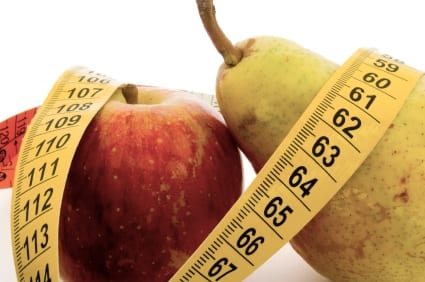
You’ve probably heard about the fruit-based analogies to describe body shape. “Apples” tend to carry more weight around their waist whereas “pears” tend to be heavier around the hips and thighs. But the differences between apples and pears extend beyond simple appearance. Studies have shown that physical shape, primarily where you carry your excess weight, can have a profound impact on your overall health. Bad news for the apples … people who are rounder around the middle appear to be at greater risk for developing heart disease and type 2 diabetes than their pear-counterparts.
So, which fruit are you? One way to determine your body fat distribution pattern is to calculate your waist-hip ratio (WHR) by dividing the distance around your waist (measured just above the belly button) by the distance around your hips (measured at the widest part). A WHR over 0.8 for women or 0.95 for men is considered high and categorized as a risk factor for metabolic disease.
In a recent publication from Nature Genetics, a team of scientists from the Genetic Investigation of Anthropometric Traits (GIANT) report their findings from a two-phase study into how genetics influence waist and hip size. This investigation, including nearly 200,000 people of European descent drawn from more than 50 studies, is one of the largest genetic studies ever carried out for any trait. Following an impressive data analysis effort, authors announced the identification of 14 SNPs (13 new and one previously reported) associated with body fat distribution.
In addition to exciting new SNP discoveries, results from this study suggest that genetics play a more significant role in determining body fat distribution in women than in men. In women, not only do more of the SNPs associate with WHR (12 of 14 SNPs compared to three of 14 SNPs in men), but they also appear to have greater influence on waist and hip size.
The study authors also hint at potential associations between the 14 SNPs identified in their research and common risk factors for heart disease and type 2 diabetes. For example, the T version of showed strong associations with elevated triglycerides and insulin resistance. The risky versions of , ( in the 23andMe database*), and also demonstrate significant association with type 2 diabetes.
As with obesity and many other conditions with a strong environmental component, genes only account for a small piece of the puzzle underlying variability in body fat distribution. Even so, this study establishes an important observation: the SNPs associated with body fat distribution (measured by WHR) appear to be mostly distinct from those SNPs associated with overall body fat content (measured by body mass index (BMI)). Since the location of body fat plays a pivotal role in disease risk, a better understanding of the genetic risk factors underlying increased waist and hip size may lead to improved therapies or lifestyle recommendations.



